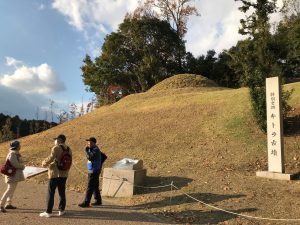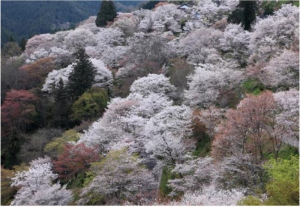 While Yoshino is a beautiful area throughout the entire year, it is perhaps most famous for its cherry blossoms that bloom every spring on Mt. Yoshino. There are so many that it feels like a fantasy world. As we climb up and down paths surrounded by these flowers, a cool breeze might blow a wave of petals off the branches and around our heads. As we climb higher, we might get a great view of the flowers and trees on the mountains around us as well, which always makes me feel like I am walking through the clouds.
While Yoshino is a beautiful area throughout the entire year, it is perhaps most famous for its cherry blossoms that bloom every spring on Mt. Yoshino. There are so many that it feels like a fantasy world. As we climb up and down paths surrounded by these flowers, a cool breeze might blow a wave of petals off the branches and around our heads. As we climb higher, we might get a great view of the flowers and trees on the mountains around us as well, which always makes me feel like I am walking through the clouds.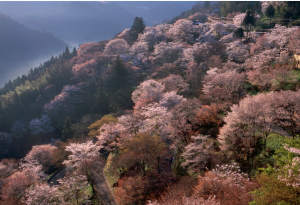
If you visit large parks, riversides, or other places at this time of year, you are likely to see many people picnicking around these beautiful flowers. When I first came to Japan as a student, one of my favorite experiences was gathering at a park with my school club and enjoying the cherry blossoms. There were so many people who had come to the park, that we ended making many new friends. Cherry blossoms have a unique power in that way. They help us relax a little, take a break from our busy every day lives, and enjoy the moment.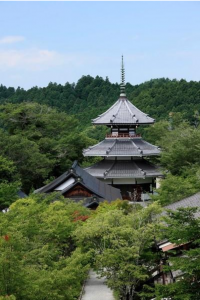
With the cherry blossoms in full bloom, this is the perfect time of year to enjoy Mt. Yoshino. In addition to walking through these pink clouds, we have a tour that will let you feel the history of this mountain in its many temples and shrines. Just ride the Kintetsu Yoshino Line to the end of the line, and step into our blooming world of wonder.
No. 330 – An Introduction to Yoshinoyama (Uphill Course)

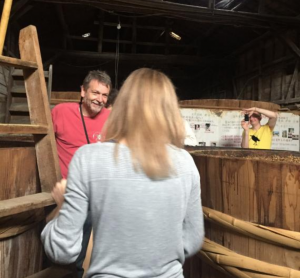
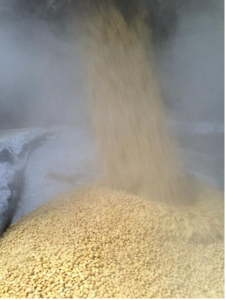
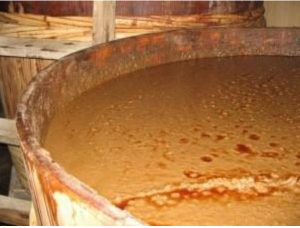
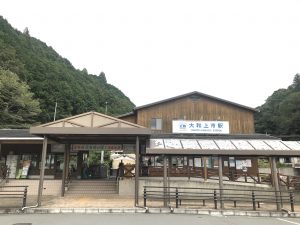
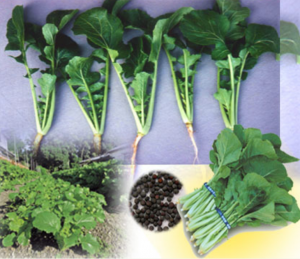
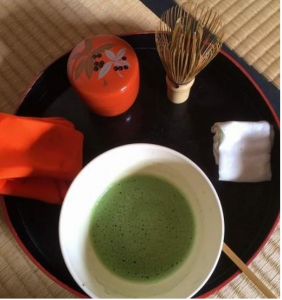 That is why some teachers decide to meet their students half way. By moving the practice to a table top and chairs, students can focus on elements of tea ceremony more important than sitting. Students can learn about the flow, the utensils, and the heart and mind of cha-no-yu. They can learn how the season is reflected in the utensils, decorations, and sweets. They can focus on appreciating the beauty of these items, and the efforts the host must have gone through to prepare them. Doing all this, in a painless way none the less, helps ensure that everyone has a nice time together.
That is why some teachers decide to meet their students half way. By moving the practice to a table top and chairs, students can focus on elements of tea ceremony more important than sitting. Students can learn about the flow, the utensils, and the heart and mind of cha-no-yu. They can learn how the season is reflected in the utensils, decorations, and sweets. They can focus on appreciating the beauty of these items, and the efforts the host must have gone through to prepare them. Doing all this, in a painless way none the less, helps ensure that everyone has a nice time together.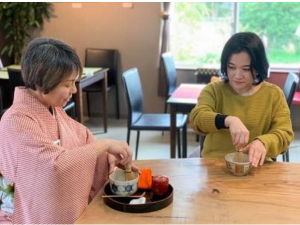 Nara is home to some of the most famous pottery and tea whisks in Japan, and produces lots of tea in its rolling hills, so its connection with tea ceremony goes back to the art’s beginnings. Perhaps one of the ways of keeping this tradition alive and well is to make it more accessible for newcomers, and we have a program that takes a step in that direction. Music Cafe Anges in Kashihara City offers participants the chance to learn about tea ceremony and whisk a bowl themselves in the comfort of a table and a chair. Participants don’t just learn about the process, but also the philosophy of this ancient art. With tea produced in Nara and traditional sweets from a popular local shop, it is a chance to comfortably experience a tea ceremony unique to this place and this time. If you are interested, please check the link below.
Nara is home to some of the most famous pottery and tea whisks in Japan, and produces lots of tea in its rolling hills, so its connection with tea ceremony goes back to the art’s beginnings. Perhaps one of the ways of keeping this tradition alive and well is to make it more accessible for newcomers, and we have a program that takes a step in that direction. Music Cafe Anges in Kashihara City offers participants the chance to learn about tea ceremony and whisk a bowl themselves in the comfort of a table and a chair. Participants don’t just learn about the process, but also the philosophy of this ancient art. With tea produced in Nara and traditional sweets from a popular local shop, it is a chance to comfortably experience a tea ceremony unique to this place and this time. If you are interested, please check the link below.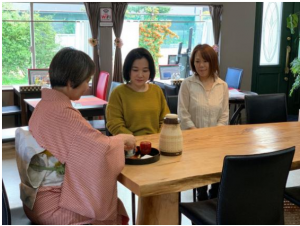
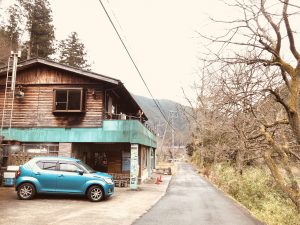

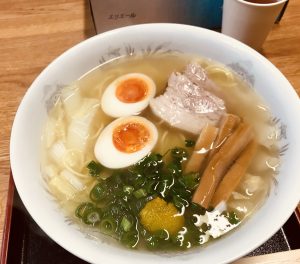
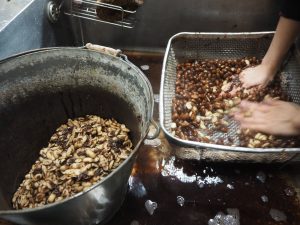 “Yokan” is a Japanese dessert made from mashed beans and gelatin, and often flavored and colored as well. Every winter, Asahikan in Kawakami Village makes its “yuzu yokan” from scratch. They boil the beans in a wood-fire pot, then rinse them and skin them before mashing them up to be used in the dessert. They continue to use a recipe and methods that have been passed down through generations, including picking the yuzu, a citrus fruit, from trees nearby. Flakes of the fruit’s yellow skin add a subtle flavor to the yokan’s sweetness, and a bright element to the already pink-colored dessert.
“Yokan” is a Japanese dessert made from mashed beans and gelatin, and often flavored and colored as well. Every winter, Asahikan in Kawakami Village makes its “yuzu yokan” from scratch. They boil the beans in a wood-fire pot, then rinse them and skin them before mashing them up to be used in the dessert. They continue to use a recipe and methods that have been passed down through generations, including picking the yuzu, a citrus fruit, from trees nearby. Flakes of the fruit’s yellow skin add a subtle flavor to the yokan’s sweetness, and a bright element to the already pink-colored dessert. 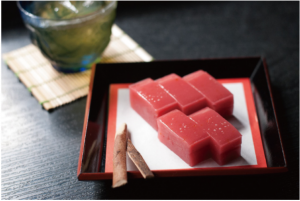 As a 130-year-old traditional Japanese inn, Asahikan offers guests the opportunity to experience what staying in the countryside might have been like in a previous era. With its traditional architecture, including a stunning garden on its second floor, you can walk the same wooden halls and stay in the same tatami rooms as its many visitors have done for over a century.
As a 130-year-old traditional Japanese inn, Asahikan offers guests the opportunity to experience what staying in the countryside might have been like in a previous era. With its traditional architecture, including a stunning garden on its second floor, you can walk the same wooden halls and stay in the same tatami rooms as its many visitors have done for over a century.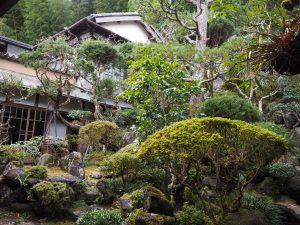 If you are looking for some outdoor fun as well, we offer an experience in which you can stay at Asahikan, chop some bamboo from its mountain grove, and turn that bamboo into your own lunchbox. You’ll take that lunch with you when you go out to explore the wide variety of moss in our village, and then create your own moss terrarium. Young or old, all ages are welcome!
If you are looking for some outdoor fun as well, we offer an experience in which you can stay at Asahikan, chop some bamboo from its mountain grove, and turn that bamboo into your own lunchbox. You’ll take that lunch with you when you go out to explore the wide variety of moss in our village, and then create your own moss terrarium. Young or old, all ages are welcome!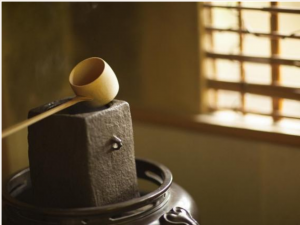
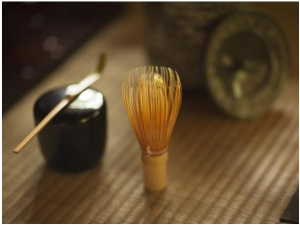
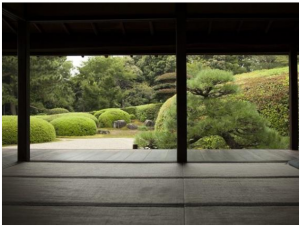
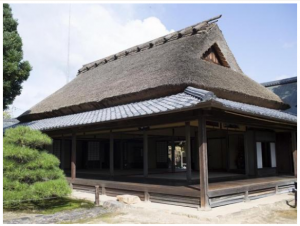
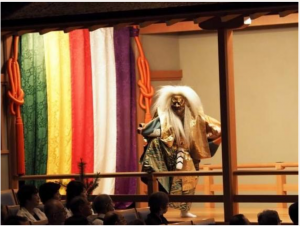 “An empty sky of music, a rain of flowers, strange fragrance on every side; all these are no common things, nor is this cloak that hangs upon the pine tree…”
“An empty sky of music, a rain of flowers, strange fragrance on every side; all these are no common things, nor is this cloak that hangs upon the pine tree…”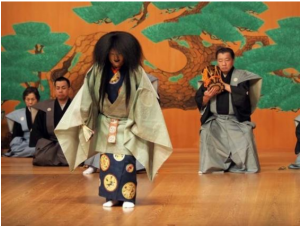 It is a traditional story of an interaction between a fisherman and a Tennin, an aerial spirit or celestial dancer. It takes place in an old world that feels both simpler and more susceptible to visits from aerial spirits.
It is a traditional story of an interaction between a fisherman and a Tennin, an aerial spirit or celestial dancer. It takes place in an old world that feels both simpler and more susceptible to visits from aerial spirits.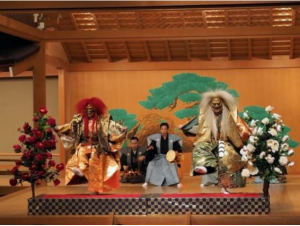 Though most of us just read these stories, visitors to Nara will have the chance to learn and feel the power of Noh and what this story is about. Twice in early February, 2020, a Noh experience and workshop will be held at Kasugano International Forum IRAKA in Nara City. First, participants will have the chance to view a performance and learn about the story, the roles in Noh, and the instruments used in the performance. Then in the workshop, participants can try on some of the costumes and play one of the instruments. It is a rare chance to cross into a world that is usually exclusive to performers and professionals, and feel both the power of this story and the sights, sounds, and textures of the traditional Japanese art.
Though most of us just read these stories, visitors to Nara will have the chance to learn and feel the power of Noh and what this story is about. Twice in early February, 2020, a Noh experience and workshop will be held at Kasugano International Forum IRAKA in Nara City. First, participants will have the chance to view a performance and learn about the story, the roles in Noh, and the instruments used in the performance. Then in the workshop, participants can try on some of the costumes and play one of the instruments. It is a rare chance to cross into a world that is usually exclusive to performers and professionals, and feel both the power of this story and the sights, sounds, and textures of the traditional Japanese art. 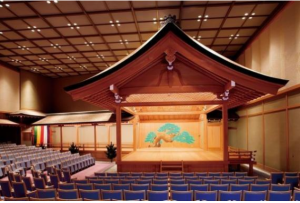
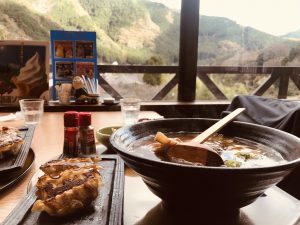 Another term for ramen in Japan is Chuka-men, or “Chinese noodles”. I ordered the Chuka-men combination with gyoza, and enjoyed the great scenery while I waited for my food. Sato offers a wide view of the endless mountains of Yoshino cedar, and the calming Yoshino River running below.
Another term for ramen in Japan is Chuka-men, or “Chinese noodles”. I ordered the Chuka-men combination with gyoza, and enjoyed the great scenery while I waited for my food. Sato offers a wide view of the endless mountains of Yoshino cedar, and the calming Yoshino River running below. 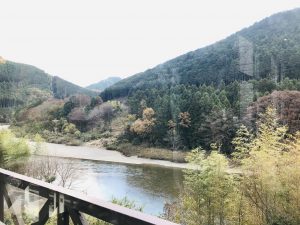 My food eventually arrived on a tray that seemed like it could cover the entire table, and in addition to my noodles and gyoza, included rice, stewed vegetables, and pickles. My bowl of noodles had a soy sauce based broth with slices of pork, half a hard-boiled egg, green onions, and popular Japanese vegetables like napa cabbage and bamboo shoots. The gyoza was perfect! Crispy, flavorful, and huge! After finishing everything on my tray, I wasn’t sure if I’d be able to walk out the door.
My food eventually arrived on a tray that seemed like it could cover the entire table, and in addition to my noodles and gyoza, included rice, stewed vegetables, and pickles. My bowl of noodles had a soy sauce based broth with slices of pork, half a hard-boiled egg, green onions, and popular Japanese vegetables like napa cabbage and bamboo shoots. The gyoza was perfect! Crispy, flavorful, and huge! After finishing everything on my tray, I wasn’t sure if I’d be able to walk out the door.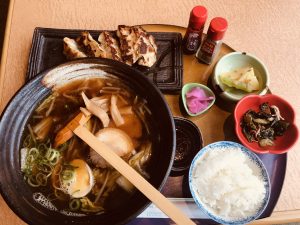 Signed photos and autographs near the entrance show how popular of a stop Sato is among celebrities who pass through. Sato is also a very popular place among the locals, and even with all that fame, the staff always makes an effort to remember faces and names. Even if it is your one and only visit there, I am sure they will welcome you very warmly! As I mentioned, they still have a giant menu, so I recommend going there multiple times and trying something new every time.
Signed photos and autographs near the entrance show how popular of a stop Sato is among celebrities who pass through. Sato is also a very popular place among the locals, and even with all that fame, the staff always makes an effort to remember faces and names. Even if it is your one and only visit there, I am sure they will welcome you very warmly! As I mentioned, they still have a giant menu, so I recommend going there multiple times and trying something new every time.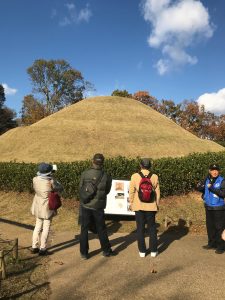
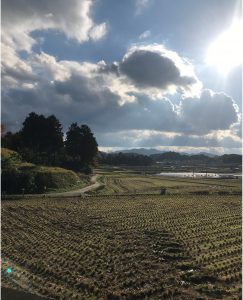
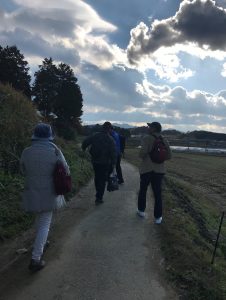
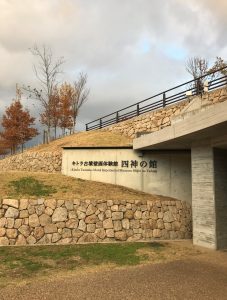 I arrived at Kitora Tomb and first headed to the Shijin-no-yakata in the Center for Preservation of Kitora Tumulus Mural Paintings.
I arrived at Kitora Tomb and first headed to the Shijin-no-yakata in the Center for Preservation of Kitora Tumulus Mural Paintings.